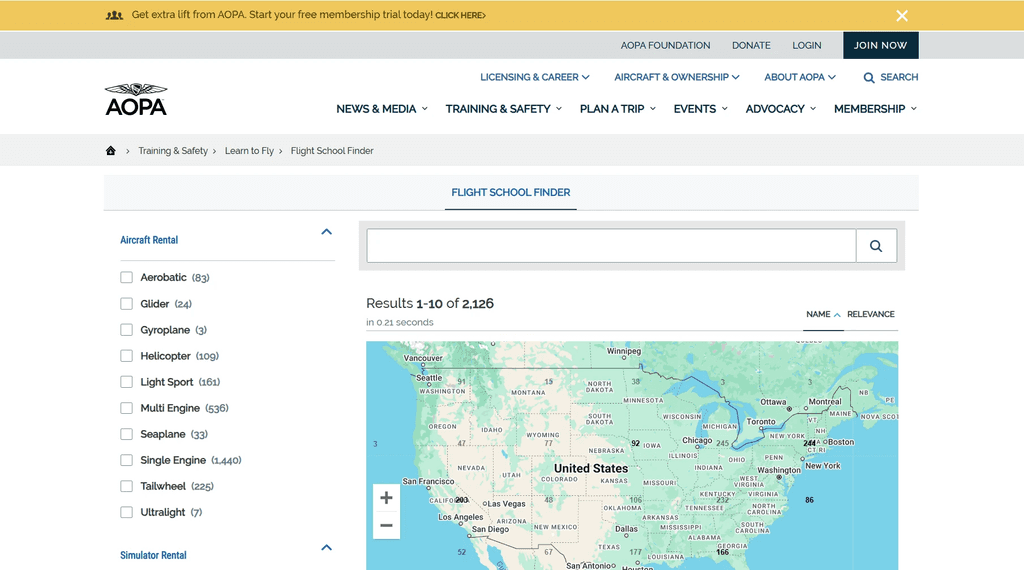Finding the right Flight School
AOPA Flight School Finder
You can use this Flight School Finder for the USA to get an Overview of Schools in your Area if you are drawn to specific locations.
Modular vs integrated
Let’s start by deciding if you want to do your training modular step by step or integrated at one school, as some schools will only accept integrated courses and others may only offer modular courses.
Integrated flight schools are only recommended for students who can attend flight school like a full-time job, which it definitely will be. It is possible to mix it with a part-time job, but this may be stressful. These schools are designed to take you from zero experience to your license as quickly as possible. However, there are many factors that can slow your training at an integrated school significantly, which we will discuss later in the guide.
On the other hand, doing your flight training modular means you can complete your training at your own pace and even switch between schools for different modules. Modular training allows you to pay for each stage individually and take breaks between phases if needed, providing greater flexibility in terms of time and cost. This path is particularly useful for students who prefer to work or study alongside their training, as it can be done part-time without the intensive schedule of an integrated program.
Payments
Obviously one of the most important aspects to take into consideration is how you finance your flight training. Some schools take a high percentage of the total training cost upfront and the rest in monthly installments. That is nearly always done at integrated schools. Other more friendly schools offer a Pay as you go system where you will just get charged after your flight. It may sound confusing but often the integrated schools that charge the cost upfront are more expensive than pay as you go schools. That is because they often charge a premium for the benefits included in their program, like quick maintenance, study resources and airline partnerships that can give you an advantage in landing an airline job.
Generally I definitely recommend a school with a Pay as you go structure and modular courses. Especially at the beginning it will minimize the risk of choosing a bad fit for you or getting stressed by unforeseen events. I have seen many student pilots that would have had made a better choice with going modular instead of integrated.
Pricing
Check for hourly rates for flying the plane and what you will have to pay for instruction per hour. Normally those prices are wet prices, which means they will include gas as well. If you get a quote for your training course, the flight school may include the minimum hour requirements and not the average. Most students need more hours than are legally required. So anything above the quoted price will be charged in hourly rates as needed.
Some flight schools that offer integrated courses have a contracted hourly rate that they will charge from a internal school account where your money will be and after you exceeded the hourly rate given on your contract, the flight school may charge a higher rate.
I started as an integrated flight student at Academy of Aviation and had to pay my tuition upfront in installments. The school keeps an internal account that gets charged after each flight with a retail rate and when requested, the school reimburses the difference between contract and retail price into my account,
I cannot recommend a school handling their students finances this way at all and would tell everyone to stay away. On the positive side, the training at Academy of Aviation was good and i had a good time.
Later on I did some training towards my CPL and Multi Engine add on at Upper Limit Aviation in Utah, who i can highly recommend. The people are very friendly, they have awesome instructors, hourly rates are good, good planes, maintenance and scheduling is efficient and they use a Pay as you go system.
Contract
Get yourself an example or just an empty contract by the school early in the process. Read through rules like no show fees and reimbursements for upfront payments. Most integrated flight schools have a very unfriendly reimbursement policy with a maximum of 50% of unused funds within 3 months of payment. Do not go into a trap like this as it can put a huge burden on you if anything goes wrong.
US Specific Part 141 vs Part 61
In the United States specifically you will find Part 141 Schools and Part 61 Schools.
To understand this, we need to compare Part 141 and Part 61 courses.
141 follows a more strict curriculum with integrated progress checks that have to be completed in order to get to the next phase of your training. The minimum hours required towards a license are lower under Part 141 but the percentage of flight hours with an instructor usually higher, whereas Part 61 is more relaxed and freely taught.
Part 141 Schools can offer training for a license under Part 141 or Part 61 whereas a Part 61 school only offer Part 61 training.
Bigger schools that are held to a higher standard by the Federal Aviation Authority operate under Part 141. these are also the only schools that are allowed to give out the I20 document needed for a Visa as a foreign Student, meaning that if you need a Visa to do flight training in the United States, you have to go with a Part 141 School.
Scheduling
Another Factor is Scheduling. How does the Flight school manage their schedule? How much booked is the schedule normally? If you plan on attending flight school full time and the schedule is crowded, you may need to fight for each flight. Consult with your potential or any flight instructor from the school how often you could take it to the skies per week.
Instructor, Student and Plane Ratio
Many flight schools like to take on as much students as they can, especially if they charge the tuition upfront as to fill up their pockets. Some set a limit for themselves in order to minimize the magical student to instructor ratio and the student to aircraft ratio. It means what you think: how many student is one flight instructor teaching? Generally I would say a good ratio is anything up to 1:10 for part time students and 1:5 for full time students.
Maintenance
Planes need maintenance, and that definitely more often than the average car. It can be a huge plus if the school has their own maintenance facilities as they can accommodate any unexpected mechanical issues and turn around mandatory inspections in a short time.
Location
Lastly one of the main concerns is the location. If you want to stay in your area, look through the web or just show up at your local airfield and ask around about local flight schools. You will always get the best information in aviation by talking to people.
If you are more or less independent of your location, choose a region with generally good weather, meaning lots of sun and less clouds and winds.
Next to the obvious location factors, check how big the airport is, how many flight schools are on site and how much traffic they have.
It will save you lots of time waiting and give you more time flying if you choose a smaller airport where there may be just one flight school and not many other planes. To practice in denser airspace’s, you can still go to bigger airports later on in your training, but I recommend not to get thrown into the big pond right away and feel overwhelmed with the communication and traffic input.

